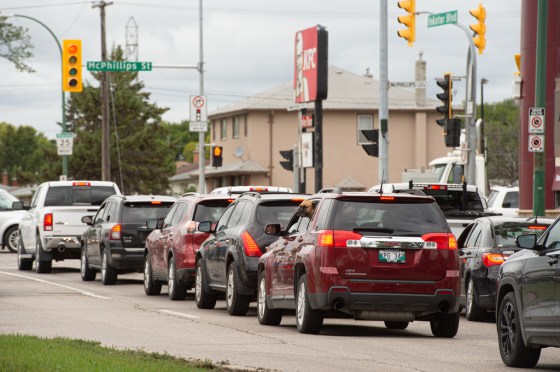The Macro
Travelling home around 7 p.m. last week, after refereeing a hockey game in the northeast part of the city, I encountered what appeared to be rush-hour-level traffic in several areas around downtown.
The worst was Stradbrook Avenue westbound from Donald Street through to Main Street. Dusk had set in, and yet there was a steady stream of traffic filling both lanes heading towards the Norwood Bridge. Construction on the bridge and on St. Mary’s Road was definitely a factor. But construction alone doesn’t explain why there were so many vehicles on the road at that time.
The problem is not just in that one area. In the past, I could count on lower traffic volumes after 6 p.m. Now, it seems as if post-6 p.m. traffic jams are the new normal.
How bad is Winnipeg’s rush hour? Have the dynamics changed? And if so, what’s behind it?
On the first two points, traffic here is inexplicably bad, and there most definitely has been a change in rush hour patterns.

How can we deal with our traffic crunch? (Mike Sudoma / Free Press files)
There are several excellent sources of drive-time data available these days, most of which rely on what is commonly referred to as “floating car” data. This is the information that can be collected anonymously from moving vehicles using geo-localization devices that are built into many newer cars. In some instances, data can be collected from cellular phones to account for cars that do not have GPS devices.
The results for Winnipeg are insightful, and a little depressing. In short, Winnipeg’s traffic congestion is (lamentably) comparable to much larger cities.
Overall, INRIX found that our peak traffic periods have changed over the last four years, with increased midday traffic and congestion that extends beyond the normal daytime commuting rush hours.
How did Winnipeg rank?
In 2023, Winnipeg was third out of all Canadian cities, with a 19-minute, 20-second average commute, according to the TomTom global traffic index, which ranks cities based on the time it takes to travel 10 kilometres at peak congestion.
Our average commute time is longer than the average in larger cities such as Montreal, Edmonton and Calgary. Toronto came in first (29 minutes) and Vancouver came second (23 minutes, 10 seconds). These findings were upheld by data from engineering firm INRIX, which also publishes an annual global traffic index. INRIX uses a slightly different approach to ranking cities, measuring the total distance a vehicle can travel from the city centre at various times of the day. The results are presented in a fantastic animated map, showing the trends since 2019.
INRIX found that in 2019 rush hour traffic, you could drive from Portage and Main to the far, western edge of Headingley in 30 minutes; today, you’d be lucky to make it to the Perimeter Highway in half an hour.
OK, so traffic flow is changing and it’s getting worse. Why?
Population growth is certainly part of the equation. Winnipeg’s metropolitan area (which captures people who live here and those who drive in for work and other purposes from bedroom communities) has roughly 30,000 more people within its limits now than in 2019.
As well, when COVID-19 took hold in early 2020, social and economic restrictions resulted in many people losing their jobs while others started working from home full-time. This led to a drastic decrease in traffic volumes at all times of day.
As pandemic restrictions eased, traffic surged again as many of those people who toiled in home offices came back to their workplaces, at least some of the time.
Hybrid working arrangements have made it difficult to predict traffic patterns. If you live near, or have to commute on, major roads feeding downtown, you’ll know traffic fluctuates quite a bit.
How can we deal with our traffic crunch? One thing we absolutely cannot do is build more high-capacity roads within the city, or extend/widen the ones we have. More and wider roads only induce more people to drive, which means traffic gets worse, not better.
Investments in a modern public transit system are the way to go. But other urban planning policies must be put in place.
Active transportation must be given a bigger role, with the city undertaking to close entire streets downtown for cycling traffic. And we have to make the downtown more walkable, possibly by closing off other streets and turning them into pedestrian malls. Changes like this make driving less attractive, which inevitably convinces more people to take transit.
We already hit above our weight when it comes to traffic congestion. Time to attack that problem with solutions that will cut down on the number of cars on our roads.
|

